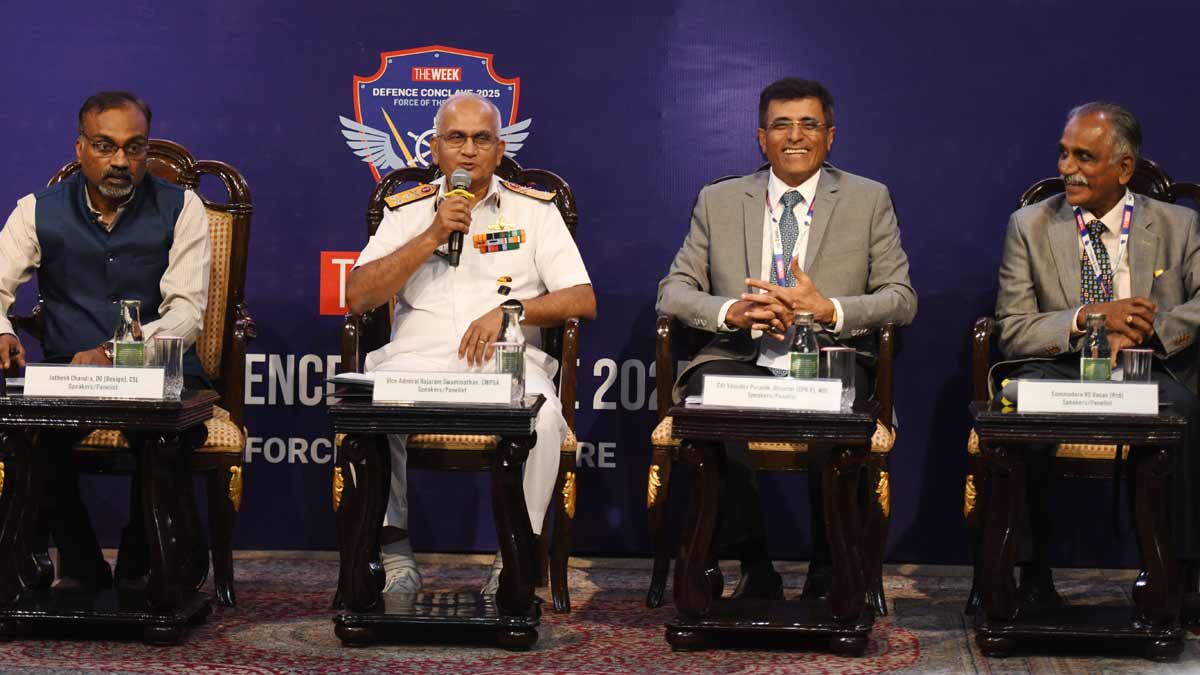‘India must strengthen naval shipbuilding to meet growing maritime demands’
 (From left) Jathesh Chandra, Director General (Design), Cochin Shipyard; Vice Admiral Rajaram Swaminathan, CWP&A (Controller of Warship Production and Acquisition); Cdr Vasudev Puranik, Director (Corporate Planning and Personnel) Mazagon Dock and Commodore R.S. Vasan (rtd), DG, Chennai Centre for China Studies during a panel discussion | Sanjay Ahlawat
(From left) Jathesh Chandra, Director General (Design), Cochin Shipyard; Vice Admiral Rajaram Swaminathan, CWP&A (Controller of Warship Production and Acquisition); Cdr Vasudev Puranik, Director (Corporate Planning and Personnel) Mazagon Dock and Commodore R.S. Vasan (rtd), DG, Chennai Centre for China Studies during a panel discussion | Sanjay Ahlawat
Amid rising maritime security challenges and global supply constraints, senior naval officials and shipbuilding experts have called for urgent steps to strengthen India’s warship-building capabilities.
As part of the THE WEEK Defence Conclave, during the session focused on ‘Building a Builder’s Navy,’ the experts emphasised the need for long-term planning, technological advancement, and strategic investments to position India as a global hub for naval manufacturing.
Vice Admiral Rajaram Swaminathan, Controller of Warship Production & Acquisition (CWP&A), said asymmetric threats and increasing pressure on global sea lanes have created a surge in demand for warships. “There is a growing necessity to secure our sea lines of communication. With shipbuilding capacity globally under strain, Chinese infrastructure fully booked, and European yards out of capacity, countries are turning to Japan and South Korea,” he said. “India must seize this moment to revive its shipbuilding ecosystem and establish itself as a reliable supplier.”
Commodore RS Vasan (Retd), Director General of the Chennai Centre for China Studies, stressed the need for India to learn from China’s rapid ascent. “China builds over 51% of the world’s ships—India contributes less than 1%. The difference is staggering,” he noted. “With 330 warships and cutting-edge technology, China has captured the global market by building the necessary infrastructure and scaling up quickly. We need to ask: why would the world come to us unless we offer similar scale and efficiency?”
CDR Vasudev Puranik, Director (Planning & Personnel), Mazagon Dock, said comparisons with China should account for historical context. “Both India and China were agrarian economies. China shifted to manufacturing in the 1990s, while India wasn’t population-ready for such a transition,” he said.
“In the next 20 years, we’ll have a robust ecosystem to support conventional submarine construction if we start making efforts on building our own production system. The capability exists; it just needs to be developed into a cohesive system.”
Jathesh Chandra, Director General (Design) at Cochin Shipyard, highlighted the practical challenges faced by Indian shipyards.
“Almost all of India’s naval vessels are now built domestically, and around 65 Navy ships are currently under construction. Yes, we’ve had cost overruns and delays in the past, but these experiences have taught us valuable lessons. We now have the knowledge and experience to move forward with greater efficiency.”
Collectively, the speakers agreed that India must act decisively to build a resilient, future-ready shipbuilding industry—one that not only meets domestic needs but also supports global partners.
Defence